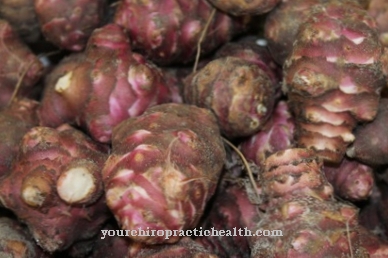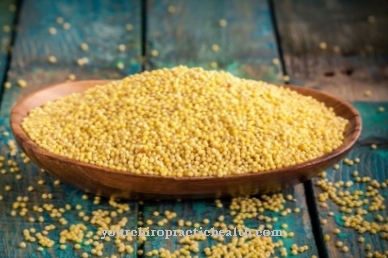The plum, a stone fruit, enjoys great popularity worldwide. The generic term plum includes several types of stone fruit. These differ in various properties, for example the juice content and the ripening time. These include the plum, mirabelle plum and Reneklode.
What you should know about the plum

The plum was already known in ancient times to be tasty and medicinal, for example due to its slightly laxative effect. The stone fruit is said to have originally come from the Caucasus and was probably brought to Greece by Alexander the Great.
The Romans brought the fruit to Germany. Through the crusaders it then spread throughout Central Europe. The plum is grown all over the world, if the climate and soil conditions are right. It developed from a cross between the sloe and the cherry plum. Since it is easy to cross, new types of fruit are created with it. In Germany, around 70 percent of the entire harvest comes from Baden-Württemberg and Rhineland-Palatinate. The smooth plums, which grow on trees up to 4 meters high, are spherical, bluish-purple or yellow-skinned with rounded ends.
Depending on the variety, the pulp is green-yellow to slightly reddish. The taste of the ripe plums is sweet and juicy, while cooked fruits are relatively sour. They are in season from July to October as they need a lot of sun for juicy and aromatic fruits to ripen.
Importance to health
Plums are considered helpful for various ailments. The fruit contains vital B vitamins, thanks to which the nerves are strengthened and the mood is lifted. The plant dyes contained are healthy antioxidants that can bind free radicals.
Consumption of many fruits has a laxative effect. They also relieve heartburn. For this, however, it is advisable to steam them, because the fruit acids they contain can be very irritating to a sensitive stomach. The plum has a diuretic and dehydrating effect. It stimulates the metabolism in diet patients with a low-salt or low-calorie diet, because the ingredients support the liver and kidneys. The B vitamins it contains are also important for an intact nervous system.
Due to the trace elements and minerals in the plum, it is a good remedy for depressive moods, nervous restlessness and stress. Due to the pectin content, the plum also helps against fever and headaches. It protects against high blood pressure and alleviates circulatory problems. It is also said to have a positive effect on rheumatism and gout. Regular consumption also prevents hardening of the arteries. Due to the particularly high proportion of fructose, they quickly provide energy. The plum also has a positive effect on beauty, because it supports the formation of collagen and firming of the skin and prevents wrinkles from forming.
Ingredients & nutritional values
Plums consist largely of water. In addition, they are made up of carbohydrates, proteins, fiber, fruit acid and a small amount of fats. In addition, the plum contains important minerals such as magnesium, iron, potassium, calcium, phosphorus, zinc and copper as well as many valuable B vitamins, vitamins C and E and provitamin A. Plums have a particularly high percentage of fructose.
Of all varieties, plums contain the most sugar. The calorie content of plums is slightly higher at around 46 calories per 100 grams of plums compared to other fruits. Prunes contain significantly more calories, because 100 grams here are around 220 calories.
Intolerances & allergies
The plum contains a lot of fructose. This makes them a quick energy supplier on the one hand, but on the other hand for people who use a Suffering from fructose intolerance, intolerance.
Fruit must always be ripe, otherwise digestion will have a hard time struggling with it and it can lead to stomach pain, gas, nausea or diarrhea. People who are older or have sensitive stomachs should choose plums because they have a softer outer skin. The firm skin of other varieties, on the other hand, needs to be chewed and crushed thoroughly so that it is not so difficult to digest.
Shopping & kitchen tips
When purchasing plums, you should make sure that they are fully ripe and have a pleasant smell. They should give in a little when pressed lightly. Soft, overripe plums are often attacked by worms. If the fruits are still too hard, this indicates immaturity.
Fresh fruits have a whitish film on the skin. However, this waxy film should only be washed off shortly before consumption, otherwise the fruit will dry out too quickly. Ripe plums are deep red-bluish and ripe plums are dark blue. Depending on the type of plum, they can be kept in the refrigerator for up to a week. Ideally, they are kept in a perforated plastic bag. Already gutted, they can also be frozen and can be kept for a maximum of one year.
It is important to remove the stone beforehand, otherwise the plums will taste bitter after thawing. Green-shelled fruits ripen without problems if they are placed in the sun for three days at room temperature, for example on the windowsill. To prevent the fruits from losing water, it is advisable to wrap them in a damp cloth. The plum kernels should not be eaten because of their poisonous hydrocyanic acid content.
Preparation tips
The plum can be used in many ways. For the preparation it is important to wash them first. Then it can be easily processed with a sharp knife. Plums are great for eating raw or for making a cake. Plums are often used for the latter. These keep their shape and consistency while baking. Fresh plum cake with sprinkles and whipped cream is an absolute delight.
You should not drink anything immediately after consuming fresh plums, otherwise digestion will be stimulated to a great extent, because the plum is known as a laxative. When cooked, the plums are ideal for making compote, jam or jelly. To do this, they should be mixed with sugar in advance so that they can draw enough juice. A bun with plum jam is the perfect way to start the day. Another classic is the plum jam, which is made from ripe plums, sugar and various spices, which can vary a little as required.
Plums also go well in a sauce, for example with pork, poultry or game. A delicious plum sauce also goes very well with chicken or duck. However, the fruits should not be cooked for too long, otherwise they will lose their taste. Plums go well with hearty dishes, for example prunes with smoked pork. The plum dumplings are very popular in Austria.













.jpg)


.jpg)











